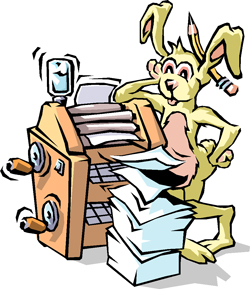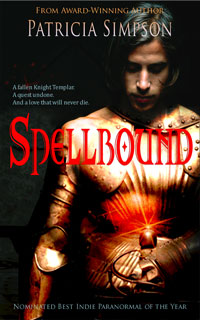Self-Publishing: The Pros and Cons
by Patricia Simpson

As the
popularity of eBooks increases, so does the temptation to self-publish. But
self-publishing isn’t for everyone. Here is the experience of a pro who has tried
both traditional and self-publishing venues.
Why I chose to self-publish
I am the author
of thirteen books published by HarperMonogram, Silhouette and TOR, and have been
published in print since the early 1990s. My novels have earned high
reviews and won numerous awards. Though I’m a midlist author, I'm not a complete unknown. So when the rights to my
older books reverted back to me, I thought why not re-publish them for the
Kindle? It couldn’t hurt to go digital. Then, a few months ago when I parted
ways with my agent and had a nearly-completed book called Spellbound on my hands, I thought, why not
try the emerging print-on-demand (POD) technology and see what happens? I’m an
early adopter of most things electronic. I’m all for going green. And this is
my story…
Publishing for the Kindle and other digital platforms
First
off, each version of a book, be it print, audio or digital needs a separate
ISBN. I had to get a new ISBN for each of the backlist titles I wanted to
publish for the Kindle. I purchased a block of ten ISBN numbers for $275 from
the U.S. ISBN Agency (www.isbn.org). Then I went to dtp.amazon.com
(This stands for digital text platform, but it’s easier for me to remember as DeskTop Publishing!) and created
a user account. To publish my book at Amazon, I needed to upload a fairly
high-resolution version of the cover (1200 x 756 pixels), and convert the book
from a Word document into the Kindle format. Conversion was tricky. The Kindle
text converter didn’t handle tabs well and misinterpreted other special
characters. It took a few tries to get the book looking the way I wanted it to
look. Though I could preview the book after it was converted, it still didn’t
look exactly like it would look on the Kindle. I bought a Kindle just to make
sure my books were formatted the way I wanted them to appear to my readers. (And
now I’m hooked on my eBook reader!)
The
bottom line with digital publishing is, you have to be a good editor, or your
book will look like a mess to your customers. People are already getting
frustrated with poor Kindle products, so be careful what you publish. Once you
are finished formatting, you publish the novel to Amazon. Your computer will
grind away for hours at this activity. Then it can take weeks for your book to
show up for sale on the Amazon site. You can go back and edit later, but it
will take weeks again for the new version to appear each time you republish.
Amazon
pays monthly. You can run reports on your sales and have your payments
deposited directly into your bank account. What a change from the old twice a
year and often cryptic royalty statements from print publishers! I make enough
each month to pay my life insurance policy from three of my old titles—and
that’s just through Amazon. There are other eBook sites out there—Fictionwise,
GoodBooks, and Mobipocket just to name a few. Before I published my backlist
novels, they weren’t earning a dime. In fact, I was still being charged for
returns by the publisher, even though the books were long out of print.

Publishing a POD book
Publishing
Spellbound as a
brand new paperback was a lot more work. First, I had to copyright Spellbound. I did this online with the
United States Copyright Office (www.copyright.gov) by paying a small fee of $35
and submitting a PDF of the novel. Next I researched POD companies. I chose
Lightning Source because they were praised for timely order fulfillment and a
product that didn’t have missing sections or pages that fell out of the
binding. (Some companies have trouble in these areas.). In addition, Lightning
Source had partnerships with distributors and booksellers, and worldwide sales outlets.
I was also intrigued by Lightning Source’s upcoming Espresso Machine
technology, where a person will be able to buy and print a book in a matter of
minutes from a kiosk. No more wasted trees. No more wasted gas carting books
around. Partnering with a forward-looking company appealed to me.
The second
step toward POD was to design the actual book using the Word document text Spellbound was written in. I come from a
desktop publishing background, so I had all the tools I needed to create a
cover and text. Following a page set-up template provided by Lightning Source, I used Adobe
Photoshop to design a cover. For artwork, I purchased two images from GettyImages.com and manipulated a photograph
I took during a trip to Scotland. (You can’t use just any old art. It has to be original
art or a royalty-free image you purchase, so your cover doesn’t infringe on anyone else’s
copyright. And the image has to be print quality, which can get expensive.)
Then I used Adobe InDesign to lay out the book.
Laying out Spellbound was no small task. I discovered
that book design is truly an art form—from choosing the right font to
tweaking the line-spacing and layout so the text landed just where I wanted it
to and in exactly the right number of pages (groups of four). Laying out my
book to keep the page count to a minimum and my costs down gave me a new
respect for book designers! This task took me days to complete—and I am
not an amateur.
Once I had Spellbound
designed just the way I wanted it, I sent it off to Lightning Source. They charged $75 for setup and $30 for a proof. I was thrilled when I got a professional-looking
product shipped to my door. However, I was not so thrilled to discover how many
typos I found once I read through Spellbound in book form. I also had another
person read the proof, and she caught even more mistakes. I can’t stress how
important the editing process is! Each mistake has to be corrected in each and
every version that you publish in print and on the web. Each time I sent in
changes to the book, Lightning Source charged an additional $30 for a new
proof. But their product was lovely and professional, and their service was excellent.
Turnaround time was only a couple of weeks for them to submit Spellbound to their
bookselling partners.
For a
small subscription fee per quarter ($12), Lightning Source lists my title in a
book catalog that Ingrams, Amazon, and Barnes and Nobles uses. Other than the
setup fees, I didn’t have to invest any more money because POD titles don’t
have print runs and storage costs. Whenever a person orders Spellbound, Lightning Source prints a copy, ships
the book to the vendor, and puts about $4.00 in my bank account. I don’t have
to spend my time fulfilling orders or invoicing booksellers. Lightning Source pays
monthly, and has a website where an author can track their sales at all times. Spellbound
has been on the market since May 2009
and by the end of the year had earned nearly a third of what I normally would have received as
an advance from a New York publisher. But the advantage to this process is that
Spellbound won’t
be remaindered for a good long while, sales keep coming in, my earnings
aren’t being held against returns, and I won’t be charged for returns at a
later date.
Listed
below is a chart comparing self-publishing to traditional publishing.
| Self-Publishing vs Traditional Publishing
|
|
Self-Publishing |
Traditional |
| Money |
No advance
Earn 1-50% cover price |
Advance (decreasing, though)
Earn 8-12% cover price |
| Earnings |
Monthly |
Biannually |
| Upfront Fees |
$35 – copyright
$28 – ISBN
$105 – Setup and proof (POD)
(Design fees not included)
$12 Quarterly catalog listing
$5 ea. – Author copy of book
|
None
Author copies included as part of contract.
|
| Marketing |
Do-it-yourself |
Some, but mostly for lead authors |
| Book Design |
Do-it-yourself or pay design fee |
Done in-house |
| ARCs & Reviews |
Pay for and send out yourself |
Provided by publisher |
| Editing |
Do-it-yourself, more control (can be dangerous!) |
Provided by publisher |
| Shelf-life |
Not available in stores. Has to be ordered from catalog. |
1 month + in stores, depending upon sales |
| Bookstores |
Won’t pre-order unless you provide copies and invoice them. |
Publisher provides copies on consignment. |
| Environmentally-friendly |
No returns, no extra copies to store |
Charge you for returns, trucking involved, trees wasted, etc. |
| Contests |
Can’t enter most contests because book is considered a “vanity press” item |
Qualify to enter, but must send in your own books |
| Taxes |
Bookkeeping your responsibility |
Publisher sends you 1099R form |
| PR |
Responsible for your own PR |
Minimal PR provided |
| Resources Required |
Website, mailing list, computer, artwork, desktop publishing software, ISBN, copyright. |
Everything supplied but computer you write on. |
| Unpublished writer |
Not recommended unless you have mass amounts of money to spend on PR and a GREAT
book (rare). |
Recommended to establish name recognition and sales record. |
| Piracy |
Once book is in digital form, pirated copies show up all over the web. You are responsible for asking sites to take down the titles you own. |
Some publishers are policing pirate sites for their authors. |
Is self-publishing for you?
Yes, if
you are capable of writing, editing, producing and
marketing your own book. Yes, if you are willing to spend time away from actual
writing to promote your book and can wait for long-term returns instead of requiring
an immediate advance. And yes, if you are an established writer with name
recognition and a massive mailing list.
The biggest drawback to self-publishing is lack of market exposure. A person can’t just go
to a supermarket and discover your beautiful book at the checkout stand. A
reader has to know who you are, what your newest title is, order it, and wait
for it to be mailed to them. Even when eReaders become the norm and digital
books are acquired in a matter of seconds, an author will still have to get the
word out to readers. If you don’t have money to spend on advertising, your book
will get lost among the hundreds of other titles being offered each month. And
it’s only going to get worse as publishing becomes easier and cheaper.
The publishing world is definitely changing, and I'm thrilled to be part of the new wave of digital authors.
About the Author
Patricia Simpson is the author of fourteen paranormal romances and is a member of the
San Francisco Area Romance Writers of America. Her POD project is entitled Spellbound, and is selling briskly in both
digital and paperback formats.
Spellbound – “4-1/2 Stars! Simpson
hits one out of the ballpark!” – RT Book Reviews

